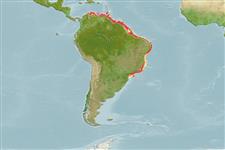>
Eupercaria/misc (Various families in series Eupercaria) >
Sciaenidae (Drums or croakers)
Etymology: Cynoscion: Greek, kyon = dog + Greek, odous = teeth + Greek, skion, skiaina = barbel, red mullet (Ref. 45335).
More on author: Cuvier.
Environment: milieu / climate zone / depth range / distribution range
Ecologie
marien; brak water demersaal; diepte 10 - 50 m (Ref. 9626), usually ? - 25 m (Ref. 9626). Tropical; 14°N - 27°S, 83°W - 34°W
Western Atlantic: Panama to Santos, Brazil. Also reported in Nicaragua (Ref. 13613).
Grootte / Gewicht / Leeftijd
Maturity: Lm ? range ? - ? cm
Max length : 90.8 cm TL mannelijk / geslacht onbekend; (Ref. 9626); common length : 35.0 cm TL mannelijk / geslacht onbekend; (Ref. 3702); max. gepubliceerd gewicht: 2.0 kg (Ref. 5217)
Dorsale stekels (totaal) : 11; Dorsale zachte stralen (totaal) : 20 - 24; Anale stekels: 2; Anale zachte stralen: 8 - 10. Silvery bluish on back, often with greenish reflections. Whitish on belly. Upper sides sometimes with inconspicuous minute dark dots. Soft portion of dorsal fin and caudal fin edged with black, pelvic and anal fins yellowish. Inside of opercle dark, visible externally. Mouth large, pointed, lower jaw projecting. Upper jaw with a pair of large canine-teeth at tip. Chin without barbel or obvious pores. Snout with 2 marginal pores. Gas bladder with a pair of curved, horn-like anterior appendages. Scales small, all cycloid (smooth). Soft dorsal-fin base with 1 or 2 rows of scales along its base (Ref 51721).
Found over mud and sand bottoms in river estuaries. Occurs up to 50 m but usually less than 25 m (Ref. 9626). Marketed fresh and salted.
Levenscyclus en paargedrag
Maturiteit | Voortplanting | Paaien | Eieren | Fecunditeit | Larven
Cervigón, F., 1993. Los peces marinos de Venezuela. Volume 2. Fundación Científica Los Roques, Caracas,Venezuela. 497 p. (Ref. 9626)
Status op de Rode Lijst van het IUCN (Ref. 130435: Version 2024-2)
Gevaar voor de mens
Harmless
Gebruik door de mens
Visserij: commercieel; sportvis: ja
Tools
Speciale rapporten
Download XML
Internetbronnen
Estimates based on models
Preferred temperature (Ref.
123201): 24.8 - 27.9, mean 27.3 °C (based on 60 cells).
Fylogenetische diversiteitsindex (Ref.
82804): PD
50 = 0.5000 [Uniqueness, from 0.5 = low to 2.0 = high].
Bayesian length-weight: a=0.00794 (0.00512 - 0.01231), b=3.07 (2.95 - 3.19), in cm total length, based on LWR estimates for this species & Genus-body shape (Ref.
93245).
Trofisch niveau (Ref.
69278): 3.1 ±0.40 se; based on food items.
Generation time: 3.1 ( na - na) years. Estimated as median ln(3)/K based on 1
growth studies.
Weerstandsvermogen (Ref.
120179): Gemiddeld, minimale populatieverdubbelingstijd 1,4-4,4 jaar (Preliminary K or Fecundity.).
Fishing Vulnerability (Ref.
59153): Moderate vulnerability (37 of 100).
Nutrients (Ref.
124155): Calcium = 93.2 [57.6, 183.3] mg/100g; Iron = 0.965 [0.503, 1.639] mg/100g; Protein = 18.3 [16.7, 20.0] %; Omega3 = 0.195 [0.107, 0.317] g/100g; Selenium = 64.8 [36.2, 121.6] μg/100g; VitaminA = 10.7 [4.4, 26.2] μg/100g; Zinc = 1.17 [0.86, 1.67] mg/100g (wet weight); based on
nutrient studies.
